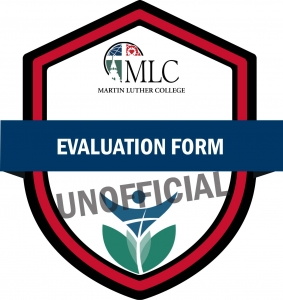MICRO-CREDENTIALS
Formal Recognition for Informal Learning
BDG0124 Evaluation Form
DESCRIPTION: Teachers who earn the evaluation form micro-credential can appreciate the importance of summative teacher evaluations. In addition, they can collect evidence needed to properly, fairly, and thoroughly rate a teacher. Finally, they also demonstrate that they can use the new WELS summative teacher evaluation rubric to both collect relevant evidence and conduct an end-of-year summative teacher evaluation conference.
EARNING THE MICRO-CREDENTIAL: Earners must collect evidence based on each of the five parts of the WELS summative teacher evaluation rubric: 1) Ministry Traits, 2) Content Knowledge, 3) Learner and Learning, 4) Instructional Practice, and 5) Professional Responsibilities. The earner provides a redacted summative evaluation teaching form from a meeting they conduct with a teacher, accompanying the collected evidence. Finally, the earner video-records the conducted year-end summative teacher evaluation meeting. Earners write a summary reflection paper on the importance of the summative teacher evaluation.
RESEARCH BASE: The research base for summative teacher evaluation is strong. A U.S. Department of Education project (2016) showed that effective teacher evaluations correlate positively with student learning. Kraft and Gilmour (2017) remind us of the need for effective summative teacher evaluation since the perceptions of evaluators and school districts seem to assume classroom effectiveness is the same from teacher to teacher, as the ratings are consistently high. Another 2016 U.S. Department of Education research project shares with us the fact that the kind of feedback received in a summative teacher evaluation directly affects teacher effectiveness. A 2017 U.S. Department of Education report does the same.
- Institute of Education Science (2016). Examining the validity of ratings from a classroom observation instrument for use in a district’s teacher evaluation system (National Center for Education Evaluation and Regional Assistance). Washington, DC: U.S. Department of Education.
- Kraft, M. and Gilmour, A. (2017). Revisiting the “widget effect:” Teacher evaluation reforms and the distribution of teacher effectiveness. Educational Researcher, 46 (5), pp. 234-249.
- Institute of Education Science (2017). The impact of providing performance feedback to teachers and principals (National Center for Education Evaluation and Regional Assistance). Washington, DC: U.S. Department of Education.
- Institute of Education Science (2016). Teachers’ responses to feedback from evaluators: What feedback characteristics matter? (National Center for Education Evaluation and Regional Assistance). Washington, DC: U.S. Department of Education.
BACKGROUND:
The following are useful tools to better understand the topic:
- WELS Summative Teacher Evaluation Form
- Module IV Summative Teacher Evaluation Resource Packet
- Lipton, L. and Wellman, B. (2013). Learning-focused supervision: Developing professional expertise in standards-driven systems. Charlotte: MiraVia.
MICRO-CREDENTIAL CRITERIA:
An Evaluation Form micro-credential earner can do the following:
- Collect instructional evidence/artifacts necessary for teacher evaluation in all domains.
- Apply evidence/artifacts collected to the summative teacher evaluation form.
- Provide meaningful feedback to improve teacher performance.
SKILL DEMONSTRATION:
Submit a completed summative teacher evaluation form (redacted) with evidence/artifacts (also redacted) to support the decisions discussed and finalized.
Include the following:
- Evidence-based ratings for the teacher.
- Explanations of how each piece of evidence supports the rating category chosen.
- Notes to generate conversation with the teacher in the evaluation conference.
Submit a video
Keep in mind the following:
- Obtain consent of the teacher to be video-recorded.
- Carry out and video-record the summative teacher evaluation meeting.
- Be sure to incorporate the use of the rubric and its components in the meeting.
- Edit the video so it is no more than 15 minutes long.
Submit a written reflection
After completing the recorded meeting, produce a written reflection (maximum 500 words, or two double-spaced pages) of the meeting that explains:
- The important components of the meeting and why they are noteworthy.
- The impact of the meeting for both you and the teacher.
-
- What went well that the evaluator would like to emulate in future meetings?
- What needs to change in order to improve the use of summative teacher evaluations?
RUBRIC:
CLICK HERE for rubric
RESOURCES:
Books
Antonetti, J. and Garver, J. (2015). 17,000 classroom visits can’t be wrong: Strategies that engage students, promote active learning, and boost achievement. Alexandria: ASCD.
Frontier, T. and Mielke, P. (2016). Making teachers better not bitter: Balancing evaluation, supervision, and reflection for professional growth. Alexandria: ASCD.
Lipton, L. and Wellman, B. (2013). Learning-focused supervision: Developing professional expertise in standards-driven systems. Charlotte: MiraVia.
Marzano, R. and Toth, M. (2013). Teacher evaluation that makes a difference: A new model for teacher growth and student achievement. Alexandria: ASCD.
Schmoker, M. (2018). Focus. Alexandria: ASCD.
Articles
Brooks, N., Solloway, S., and Anderson Allen, L. (2007). Instructional supervision and curriculum monitoring: Reinterpreting the principal’s role through the arts of inquiry. Journal of Personal Evaluation in Education, 20, 7-16.
Delvaux, E., Vanhoof, J., Tuytens, M., Vekeman, E., Devos, G., and VanPetegem, P. (2013). How may teacher evaluation have an impact on professional development? Teaching and Teacher Education, 36, 1-11.
Ediger, M. (2009). The principal in the teaching and learning process. Education, 129(4), 574-578.
Elgarten, G. (1991). Testing a new supervisory process for improving instruction. Journal of Curriculum and Supervision, 6(2), 118-129.
Klump, J. and Barton, R. (2007). Building instructional leadership. Principal’s Research Review, 2(5), 1-6.
Lunenberg, F. (2010). The principal as instructional leader. National Forum of Education and Supervision Journal, 27(4), 1-7.
National Center for Analysis of Longitudinal Data in Education Research (2009). Principal time use and school effectiveness. (Urban Institute from the Institute of Education Sciences). Washington, DC; U.S. Department of Education.
National School Boards Association (2013). Trends in teacher evaluation: How states are measuring teacher performance. (Center for Public Education). Washington, DC: U.S. Department of Education.
New Teacher Project (2010). Teacher evaluation 2.0. http://www.tntp.org
Papay, J. (2012). Refocusing the debate: Assessing the purposes and tools of teacher evaluation. Harvard Educational Review, 82(1), 123-167.
Range, B., Scherz, S., Holt, C., and Young, S. (2011). Supervision and evaluation: The Wyoming perspective. Education Assessment and Evaluation, 23, 243-265.
Richardson, J. (2008). Principals cultivate support to nurture new teachers. The Learning Principal, 3(7), 1, 6-7.
Tuytens, M. and Devos, G. (2011). Stimulating professional learning through teacher evaluation: An impossible task for the school leader? Teacher and Teacher Evaluation, 27, 891-899.
Vecchio, R. and Boatwright, K. (2002). Preferences for idealized styles of supervision. The Leadership Quarterly, 13, 327-342.
Videos
Making Teacher Evaluations Meaningful for Teachers, for Administrators, and for Students by Charlotte Danielson – https://www.youtube.com/watch?v=KzDcYuSsU2E
Martin Luther College Courses
EDU5302 Supervision of Instruction – 3 credits (graduate level)




